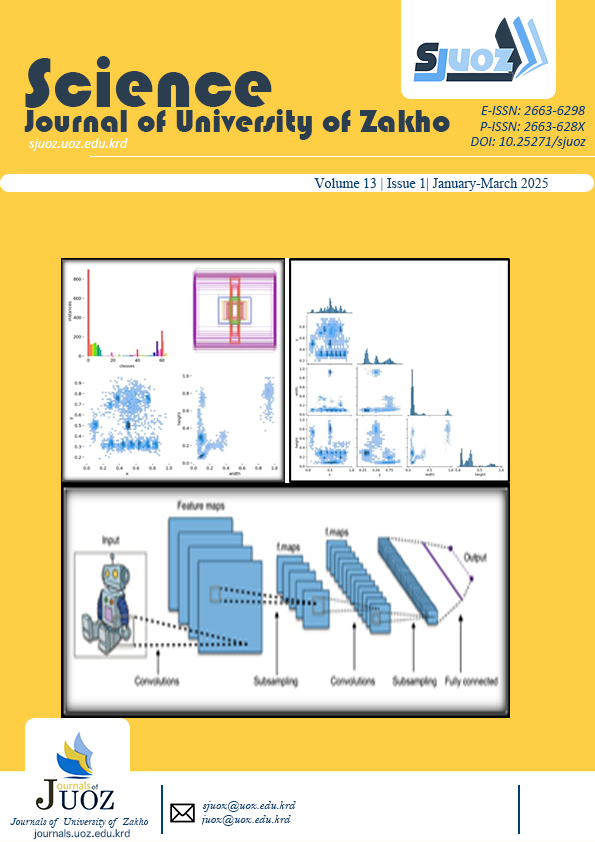DEVELOPING A COST-EFFECTIVE MICROPREDATION PROTOCOL FOR TWO CARNATION (DIANTHUS CARYOPHYLLUS L.) VARIETIES UNDER IN VITRO CONDITIONS
Abstract
A successful attempt was made through this investigation to develop a cost-effective protocol for two varieties of carnation (Dianthus caryophyllus L.) ornamental plants named Clove Pink and Scarlet. Healthy and vigorous cultures were established by inoculating axillary buds on MS medium after a successful disinfestation process by sterilizing in 2.5% NaOCl for 10 minutes. The microshoots were multiplied by testing different benzyladenine (BA) and kinetin concentrations. Luckily, the best multiplication parameters were achieved with MS medium free of growth regulators, which will reduce the propagation costs. The higher number of shoots (11.60 shoots/ explant), leaves (59.80 leaves/ explant), and longest shoots (10.90 cm) when grown on MS medium without Plant growth regulators (PGRs), Additionally, the clove pink variety on MS medium with 1.5 mg l-1 BA and Scarlet variety grown on MS-free of PGRs respectively. A 100% percent rooting was achieved for both varieties when 1.5 mg l-1 Naphthalene acetic acid (NAA) was added to the culture media. The same NAA concentration for scarlet variety microshoots resulted in the highest number of roots (26.2 roots/explant) and the longest roots (9.0 cm). Successful acclimatization was observed by transferring the well-rooted plantlets to greenhouse conditions while putting them in peat moss
Full text article
References
Ahmadian, M., Babaei, A., Shokri S., and Hessami S. (2017). Micropropagation of carnation (Dianthus caryophyllus L.) in liquid medium by temporary immersion bioreactor in comparison with solid culture. Journal of Genetic Engineering and Biotechnology. 15, 309-315. DOI:10.1016/j.jgeb.2017.07.005
Ali A, Afrasiab H, Naz S, Rauf M, and Iqhbal J (2008). An efficient protocol for in vitro propagation of carnation (Dianthus caryophyllus L.). Pak. J. Bot. 40: 111-121.
Brar MS, Al-khayri M, and Klingaman GL (1995). Effect of thidiazuron and benzylaminopurine on in vitro shoot proliferation of carnation (Dianthus caryophyllus L.). Proc. Arkansas Academy Sci. 49: 30-33.
Available at: https://scholarworks.uark.edu/jaas/vol49/iss1/7
Eshoa, L. D. & Danial, Gh. H. (2023). Worthy micropropagation protocols of seven cultures of pomegranate (Punica granatum L.) cultivars in the province of Duhok, Kurdistan Region of Iraq. Science Journal of University of Zakho. Vol. 11, No. 4, pp. 499. https://doi.org/10.25271/sjuoz.2023.11.4.1160.
Duncan, D.B. (1955). "Multiple Range and Multiple F-Tests." Biometrics, 11, 1-42
Fadaladeen, L. H., Toma, R. S., Saheen, A. A., & Ahmed, H. B. (2022). A rapid micropropagation protocol for sweet potato (Ipomoea batatas L.) via tissue culture technique. Diyala Agricultural Sciences Journal, 14(1), 31-39. DOI:10.52951/dasj.22140104
Gonbad, R. A.; Sinniah, U. R.; Aziz, M. A. and Mohamad, R. (2014). Influence of Cytokinins in Combination with GA3 on Shoot Multiplication and Elongation of Tea Clone Iran 100 (Camellia sinensis (L.) O. Kuntze). The Scientific World Journal. Volume, Article ID 943054, 9 pages:7-8. https://doi.org/10.1155/2014/943054
Kanwar JK and Kumar S (2009). Influence of growth regulators and explants on shoot regeneration in carnation. Hort. Sci. 36: 140-146. DOI:10.17221/1/2009-HORTSCI
Kovac J (1995). Micropropagation of Dianthus caryophyllus sub sp. Bohemicus-an endangered endemic from the Czech Republic. Biol. 37: 27-33. DOI:10.1590/1678-4324-2016150320
Mujib A, and Pal AK (1995). Inter-varietal variation in response to in vitro cloning of carnation. Crop Res. 10: 190-194. DOI:10.1023/A:1022236920605
Pandey, S., Prakash, S., & Tripathi, V. K. (2024). Effect of Different Concentrations of Auxin as Well as Cytokinin on Shoot Initiation, Formation and Multiplication of Pepino (Solanum muricatum Ait.) cv. Valentia with MS Semi-solid Medium. Asian Journal of Advances in Agricultural Research, 24(6), 57-69. DOI:10.9734/ajaar/2024/v24i6513
Salehi H (2006). Can a general shoot proliferation and rooting medium be used for a number of carnation cultivars? Afr. J. Biotechnol. 5: 25-30.
SAS. (2001). SAS/ STAT User’s Guide for Personal computers. Release 6.12. SAS Institute Inc. Cary, NC, USA.
Samir C. Debnath, J. Hortic. Sci. Biotechnol 92 (1) (2017) 72–80, http://dx.doi.org/10.1080/14620316.2016.1224606.
Toma, R. S. (2019). Cost Effective Culture Medium for Micropropagation of Paulownia (Paulownia tomentosa Steud.) and Catalpa (Catalpa bignonioides Walt.). Arabic Journal for Agricultural Sciences, 4(2), 33-46. Egypt. Doi:10.21608/asajs.2019.52886
Toma, R., & Tamer, Y. (2016). Direct In Vitro Regeneration of Fig (Ficus carica L. CV. Benaty) from Apical and Lateral Buds. Journal of Zankoy Sulaimani-Part A, 18(1), 77-88. Available at: https://www.researchgate.net/publication/324971810_Direct_in_vitro_regeneration_in_fig_Ficus_carcia_L_Cv_
Brown_Turkey
Authors
Copyright (c) 2025 Lolav Rajab Al-Mizory, Rafail S. Toma, Fareed Khalid Yaseen

This work is licensed under a Creative Commons Attribution 4.0 International License.
Authors who publish with this journal agree to the following terms:
- Authors retain copyright and grant the journal right of first publication with the work simultaneously licensed under a Creative Commons Attribution License [CC BY-NC-SA 4.0] that allows others to share the work with an acknowledgment of the work's authorship and initial publication in this journal.
- Authors are able to enter into separate, additional contractual arrangements for the non-exclusive distribution of the journal's published version of the work, with an acknowledgment of its initial publication in this journal.
- Authors are permitted and encouraged to post their work online.
